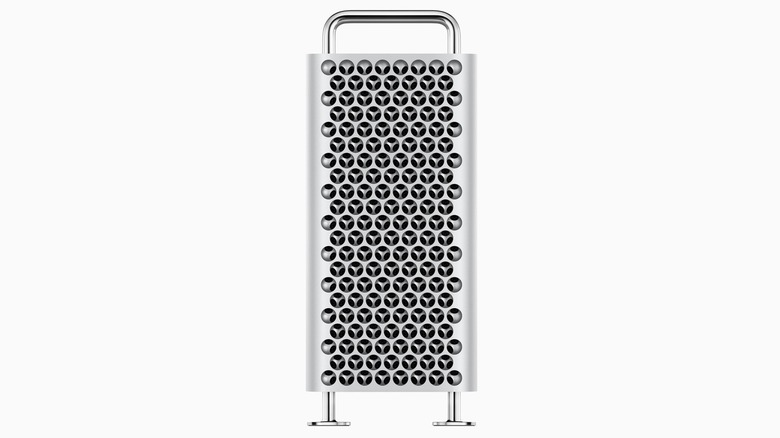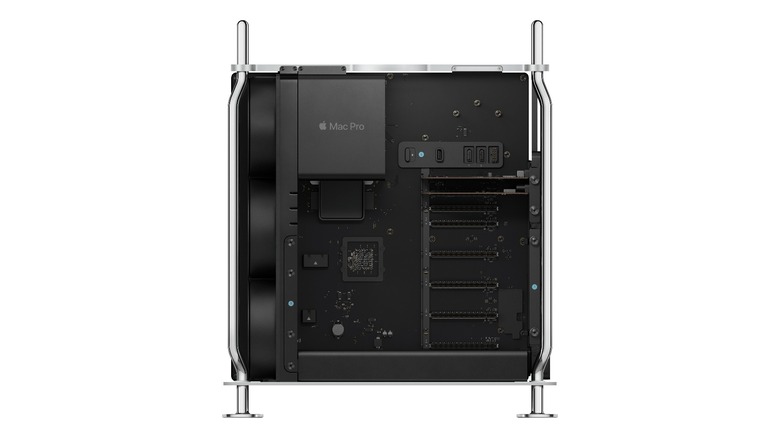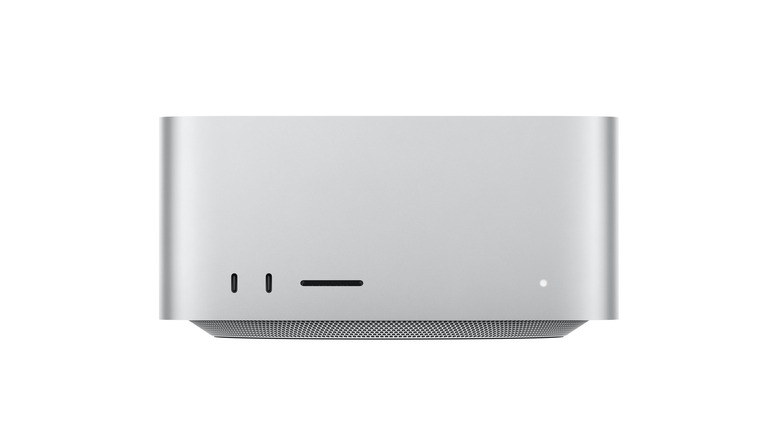The Most Impressive Features Of Apple's Most Expensive Product
In the last few years, Apple has refreshed its desktop lineup to the point that it now has four distinct desktop products, the most it's had in years. All have Apple Silicon CPUs and GPUs, and though the iMac still lags with an M1 system on a chip, the Mac Studio was introduced en route to it, the Mac Mini and the Mac Pro all being updated to having varying types of M2 SOCs. The retail price points cover a wide spectrum: Mac Minis start at $599, iMacs with built-in monitors start at $1,299, Mac Studios start at $1,999, and Mac Pros start at $6,999 for the tower version or $7,499 for the rack-mountable version.
That makes the Mac Pro easily the most expensive Apple product, an ultra-premium product earmarked for professional use, like video production. (Remember, that's just for the base configuration: Maxing out a Mac Pro to the 76-core GPU version of the M2 Ultra, 192GB memory, and an 8TB solid-state drive for storage brings the price up to $11,799.)
This is a true Mac Pro, designed with upgrades and expansion in mind, unlike some models of the past, like the infamous cylindrical 2013 Mac Pro. It kind of has to, particularly since it costs $3,000 more than a Mac Studio with the same basic configuration in terms of CPU, GPU, RAM, and storage, as the top-of-the-line M2 Ultra SOC is available in custom-ordered Mac Studios. So, let's look at the key features of the Mac Pro that differentiate it from the rest of the increasingly crowded Mac lineup.
It's the most expandable Mac on the market
What sets the Mac Pro apart from the rest of the Mac line in 2023 is how expandable it is. It has the most Thunderbolt 4 ports (which double as USB Type-C) of any Mac at eight, which are complemented by three USB Type-A ports. On its own, this wouldn't be a huge leap from the M2 Ultra Mac Studio, which has six Thunderbolt 4 ports and non-Thunderbolt USB Type-C ports.
The unique differentiator is that the Mac Pro adds a whopping seven PCI Express expansion card slots, six of which are available because the Apple I/O card uses up one of the slots out of the box. (More specifically, the Mac Pro has two full-length PCIE gen4 slots, each specced at double-wide x16, double-wide x8, and single-wide x8, plus the Apple I/O card in a single-wide half-length x4 gen3 slot.)
In practice, what does this mean? Apple's "PCIe cards you can install in your Mac Pro (2023)" page has the best answers. Apple specifies that the 2023 Mac Pro does not support adding graphics cards over PCI Express, whether to increase 3D performance or simply provide better hardware acceleration for video encoding and decoding. Apple even specifies that the M2 Ultra Media Engine "has superior performance to Afterburner," the old Apple expansion card that helped accelerate video codec performance in PCIE-capable Mac Pros. As far as what the newest Mac Pro supports, Apple lists "fiber channel cards, fiber networking cards, video and audio I/O cards, storage cards, and ethernet cards."
In practice, that's about it, though...
If you don't need any of the expandability and futureproofing that the Mac Pro provides, then the $3,000 premium over a maxed-out Mac Studio doesn't give you much. Out of the box, the Mac Pro adds two more Thunderbolt ports and one more of each of the following: USB Type-A ports, HDMI ports, and 10 gigabit Ethernet ports. It also gets rid of the Mac Studio's SDXC card reader, so you actually lose a feature in the Mac Pro, even if it's inexpensive to add it on your own.
So, if you don't need those extra ports or the ability to add networking cards, additional audio/video inputs/outputs, networking cards, or full-speed PCIE storage? Then you're wasting thousands of dollars by getting a Mac Pro instead of a Mac Studio.
Even if you need the kinds of PCI Express devices supported by Apple Silicon, there are Thunderbolt enclosures for those, and they cost less than opting for a Mac Pro instead of a Mac Studio. You only need direct PCI Express access if you need full-speed PCI Express gen4 x16 speeds, which are capable of more than six times the speed of Thunderbolt 4.
You also get a big metal case and an additional cooling fan with the Mac Pro. But unless money is no object, you need upgradability, or you absolutely adore the look of it, there's no good reason to pick the Mac Pro over the Mac Studio.


